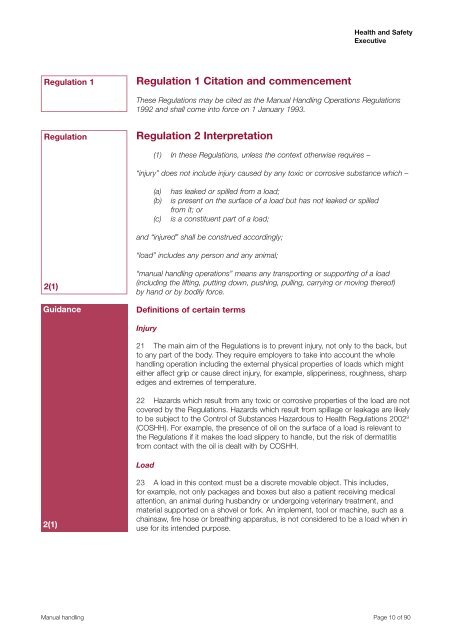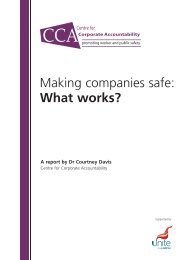Manual Handling Manual Handling Operations Regulations 1992 ...
Manual Handling Manual Handling Operations Regulations 1992 ...
Manual Handling Manual Handling Operations Regulations 1992 ...
Create successful ePaper yourself
Turn your PDF publications into a flip-book with our unique Google optimized e-Paper software.
Health and Safety<br />
Executive<br />
Regulation 1<br />
Regulation 1 Citation and commencement<br />
These <strong>Regulations</strong> may be cited as the <strong>Manual</strong> <strong>Handling</strong> <strong>Operations</strong> <strong>Regulations</strong><br />
<strong>1992</strong> and shall come into force on 1 January 1993.<br />
Regulation<br />
Regulation 2 Interpretation<br />
(1) In these <strong>Regulations</strong>, unless the context otherwise requires –<br />
“injury” does not include injury caused by any toxic or corrosive substance which –<br />
(a)<br />
(b)<br />
(c)<br />
has leaked or spilled from a load;<br />
is present on the surface of a load but has not leaked or spilled<br />
from it; or<br />
is a constituent part of a load;<br />
and “injured” shall be construed accordingly;<br />
“load” includes any person and any animal;<br />
2(1)<br />
Guidance<br />
“manual handling operations” means any transporting or supporting of a load<br />
(including the lifting, putting down, pushing, pulling, carrying or moving thereof)<br />
by hand or by bodily force.<br />
Definitions of certain terms<br />
Injury<br />
21 The main aim of the <strong>Regulations</strong> is to prevent injury, not only to the back, but<br />
to any part of the body. They require employers to take into account the whole<br />
handling operation including the external physical properties of loads which might<br />
either affect grip or cause direct injury, for example, slipperiness, roughness, sharp<br />
edges and extremes of temperature.<br />
22 Hazards which result from any toxic or corrosive properties of the load are not<br />
covered by the <strong>Regulations</strong>. Hazards which result from spillage or leakage are likely<br />
to be subject to the Control of Substances Hazardous to Health <strong>Regulations</strong> 2002 9<br />
(COSHH). For example, the presence of oil on the surface of a load is relevant to<br />
the <strong>Regulations</strong> if it makes the load slippery to handle, but the risk of dermatitis<br />
from contact with the oil is dealt with by COSHH.<br />
Load<br />
2(1)<br />
23 A load in this context must be a discrete movable object. This includes,<br />
for example, not only packages and boxes but also a patient receiving medical<br />
attention, an animal during husbandry or undergoing veterinary treatment, and<br />
material supported on a shovel or fork. An implement, tool or machine, such as a<br />
chainsaw, fire hose or breathing apparatus, is not considered to be a load when in<br />
use for its intended purpose.<br />
<strong>Manual</strong> handling Page 10 of 90
















